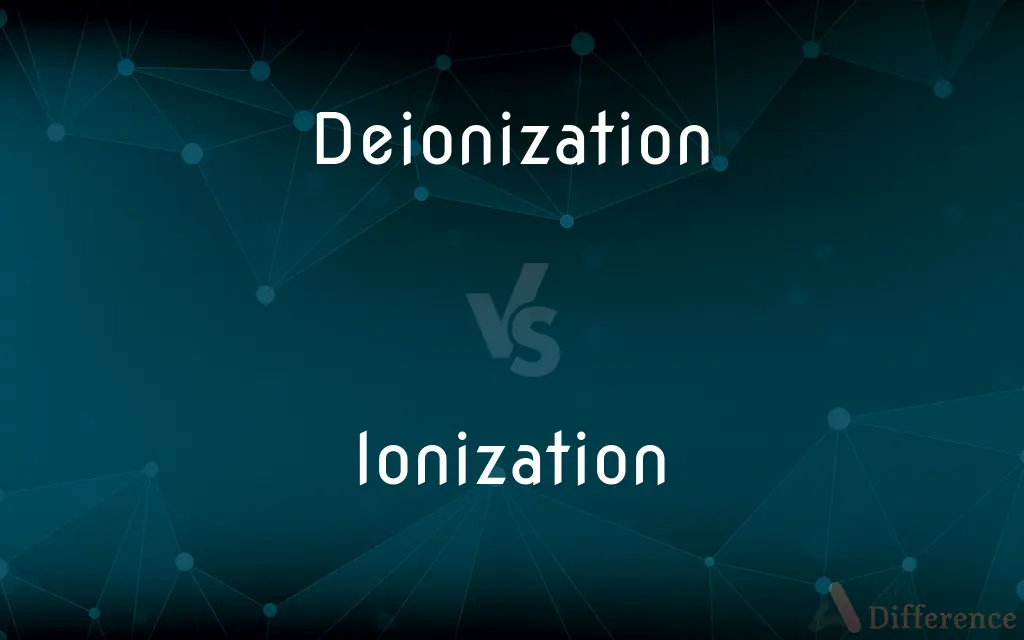Deionization vs. Ionization — What's the Difference?
Edited by Tayyaba Rehman — By Urooj Arif — Updated on March 7, 2024
Deionization removes ions from water, making it purer, while ionization involves adding or removing electrons from atoms or molecules, altering their charge.

Difference Between Deionization and Ionization
Table of Contents
ADVERTISEMENT
Key Differences
Deionization is a water purification process that removes ionized salts and other substances from water, using ion exchange resins to produce highly pure water. It is particularly useful in laboratories, pharmaceuticals, and electronics manufacturing where pure water is essential. On the other hand, ionization is a chemical process that changes the electrical charge of atoms or molecules by adding or removing electrons, resulting in the creation of ions. This process is fundamental in various chemical reactions, including combustion, photosynthesis, and in the operation of devices like ionizers and mass spectrometers.
While deionization specifically targets the removal of all ionized particles from water, making it non-conductive and chemically pure, ionization can occur in any substance and is not limited to purification purposes. Ionization plays a critical role in the environment and technological applications, such as in air purifiers where ions are used to remove pollutants from the air.
Deionization does not remove uncharged molecules such as organic compounds or microbes unless combined with other purification methods like reverse osmosis or ultraviolet disinfection. In contrast, ionization can directly alter the chemical structure of molecules and atoms, affecting their physical properties and reactivity, but does not inherently purify substances.
The equipment used for deionization, typically ion exchange columns, is designed for water treatment and requires regular maintenance to replace or regenerate the ion exchange resins. Meanwhile, ionization technologies vary widely depending on their application, from simple ionizing fans to complex scientific instruments for studying chemical and physical phenomena.
Deionization is measured by the conductivity of water, which decreases as ions are removed. Conversely, the effectiveness of ionization is often measured by its ability to produce ions, influence chemical reactions, or achieve desired outcomes in technology and research.
ADVERTISEMENT
Comparison Chart
Basic Definition
Removal of ions from water to produce pure water.
Adding or removing electrons to create ions.
Primary Use
Water purification for labs, pharmaceuticals, etc.
Altering chemical properties and in technology.
Process Focus
Removing all ionized particles from water.
Changing the charge of atoms/molecules.
Applications
Laboratories, electronics manufacturing, etc.
Chemical reactions, air purification, research.
Measurement of Effectiveness
By the conductivity of water.
By the production of ions and reaction efficiency.
Compare with Definitions
Deionization
A process to remove dissolved ions from water, enhancing its purity.
Deionization is crucial in laboratories to ensure experiments are not contaminated.
Ionization
Can occur naturally or be induced for various applications.
The ionization energy of an atom is a key factor in chemical reactivity.
Deionization
Produces demineralized water by exchanging ionized particles.
Deionized water is used in pharmaceutical manufacturing to avoid impurities.
Ionization
Affects the chemical and physical properties of substances.
Ionization can lead to the formation of new compounds through chemical reactions.
Deionization
Utilizes ion exchange resins to remove salts and other substances.
The deionization system was regenerated to maintain high water purity.
Ionization
A process that changes the electrical charge of atoms or molecules.
Ionization of air molecules is used in air purifiers to remove pollutants.
Deionization
Essential for applications requiring high levels of water purity.
Electronics manufacturing uses deionized water to clean components.
Ionization
Used in both environmental and technological applications.
Ionizers improve air quality by neutralizing odors and particles.
Deionization
Does not necessarily remove non-ionic contaminants.
Despite deionization, organic contaminants in the water require additional filtration.
Ionization
Fundamental in fields like spectroscopy and mass spectrometry.
Ionization is crucial for analyzing the composition of substances in mass spectrometry.
Deionization
(chemistry) The use of ion exchange to remove ionic substances from a solution
Ionization
Ionization or ionisation is the process by which an atom or a molecule acquires a negative or positive charge by gaining or losing electrons, often in conjunction with other chemical changes. The resulting electrically charged atom or molecule is called an ion.
Deionization
To remove ions from (a solution) using an ion-exchange process.
Ionization
The formation of or separation into ions by heat, electrical discharge, radiation, or chemical reaction.
Deionization
(chemistry) The return of an ionized gas to its neutral state
Ionization
The state of being ionized.
Deionization
The act or process of removing ions.
Ionization
Any process that leads to the dissociation of a neutral atom or molecule into charged particles ions; the state of being ionized.
Ionization
The process of converting neutral atoms or molecules into ions. The process may occur by dissolving an ionic substance in a dissociating solvent, such as water, or by adding or subtracting an electron to or from an atom or molecule. The latter process occurs, for example, in an electron beam in a mass spectrometer and by interaction of substances with ionizing radiation.
Ionization
The condition of being dissociated into ions (as by heat or radiation or chemical reaction or electrical discharge);
The ionization of a gas
Ionization
The process of ionizing; the formation of ions by separating atoms or molecules or radicals or by adding or subtracting electrons from atoms by strong electric fields in a gas
Common Curiosities
What are the applications of ionization?
Ionization is used in chemical reactions, air purification, and scientific research.
What is ionization?
Ionization involves changing the electrical charge of atoms or molecules by adding or removing electrons.
How is ionization measured?
By the ability to produce ions and influence chemical reactions or technological outcomes.
Can deionization remove organic compounds?
No, it specifically removes ionized particles; other methods are needed for organic compounds.
How do ionizers work in air purifiers?
They emit ions that bind to and neutralize airborne contaminants.
What is deionization?
Deionization is a water purification process that removes ions to produce pure water.
Is deionized water the same as distilled water?
No, deionized water is made by removing ions, while distilled water is purified through boiling and condensation.
How does deionization purify water?
It uses ion exchange resins to remove ionized salts and substances from water.
What maintenance does deionization require?
Regular regeneration or replacement of ion exchange resins to maintain effectiveness.
Why is ionization important in mass spectrometry?
It allows the analysis of chemical composition by generating ions from substances.
Does deionization make water safe to drink?
While it removes ions, it doesn't ensure water is free from all contaminants like bacteria.
Why is deionized water used in electronics manufacturing?
Its high purity prevents contamination and damage to sensitive components.
How does air ionization purify air?
By generating ions that attach to and remove airborne pollutants.
Can ionization create harmful byproducts?
In some cases, like ozone generation from some types of air ionizers, which can be harmful.
What's the difference between ionization and electrolysis?
Ionization changes charge by adding/removing electrons, while electrolysis involves using electricity to drive chemical reactions.
Share Your Discovery

Previous Comparison
Juice vs. Sauce
Next Comparison
Grande vs. TallAuthor Spotlight
Written by
Urooj ArifUrooj is a skilled content writer at Ask Difference, known for her exceptional ability to simplify complex topics into engaging and informative content. With a passion for research and a flair for clear, concise writing, she consistently delivers articles that resonate with our diverse audience.
Edited by
Tayyaba RehmanTayyaba Rehman is a distinguished writer, currently serving as a primary contributor to askdifference.com. As a researcher in semantics and etymology, Tayyaba's passion for the complexity of languages and their distinctions has found a perfect home on the platform. Tayyaba delves into the intricacies of language, distinguishing between commonly confused words and phrases, thereby providing clarity for readers worldwide.
















































